Managing Surgical Site Infections: A Public Health Perspective
VerifiedAdded on 2023/06/04
|6
|1426
|97
Report
AI Summary
This report investigates the prevalence, incidence, and risk factors associated with surgical site infections (SSIs) in Saudi Arabia, addressing the research questions related to the scope of SSI and the interventions needed to manage them effectively. It highlights the significance of SSIs as a major public health concern due to increased hospital stays, expenses, readmission risks, and mortality rates. The report references previous studies, noting Staphylococcus aureus as a common microorganism involved in SSIs and identifies risk factors such as steroid use, diabetes, obesity, and improper surgical techniques. It also emphasizes the importance of managing surgical environments, using sterile equipment, antimicrobial prophylaxis, and educating healthcare staff to prevent and manage SSIs effectively. This student contributed assignment is available on Desklib, a platform offering a wide range of study tools and resources for students.

Running head: PUBLIC HEALTH
PUBLIC HEALTH
HEALTHCARE ASSOCIATED INFECTION
Name of the student:
Name of the University:
Author note:
PUBLIC HEALTH
HEALTHCARE ASSOCIATED INFECTION
Name of the student:
Name of the University:
Author note:
Paraphrase This Document
Need a fresh take? Get an instant paraphrase of this document with our AI Paraphraser
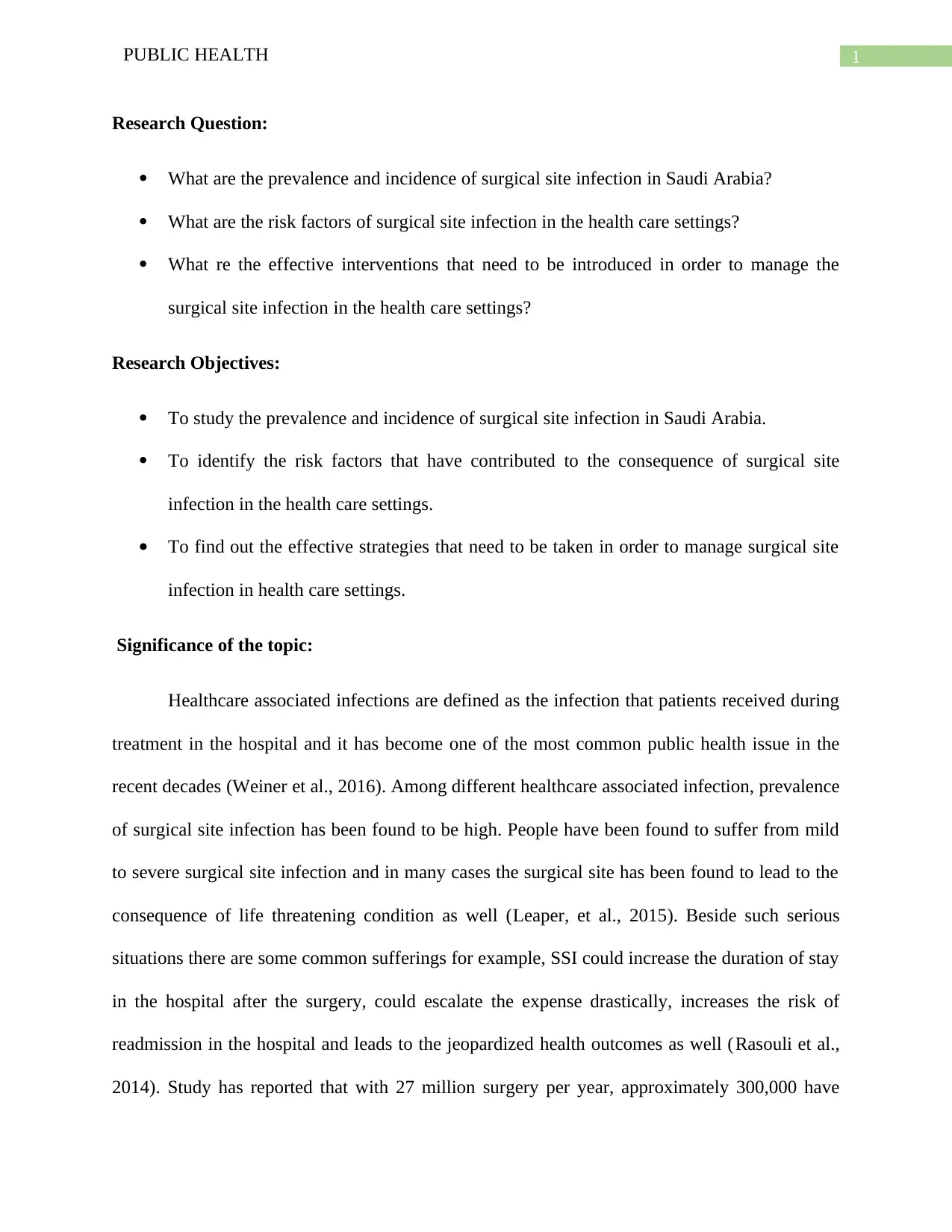
1PUBLIC HEALTH
Research Question:
What are the prevalence and incidence of surgical site infection in Saudi Arabia?
What are the risk factors of surgical site infection in the health care settings?
What re the effective interventions that need to be introduced in order to manage the
surgical site infection in the health care settings?
Research Objectives:
To study the prevalence and incidence of surgical site infection in Saudi Arabia.
To identify the risk factors that have contributed to the consequence of surgical site
infection in the health care settings.
To find out the effective strategies that need to be taken in order to manage surgical site
infection in health care settings.
Significance of the topic:
Healthcare associated infections are defined as the infection that patients received during
treatment in the hospital and it has become one of the most common public health issue in the
recent decades (Weiner et al., 2016). Among different healthcare associated infection, prevalence
of surgical site infection has been found to be high. People have been found to suffer from mild
to severe surgical site infection and in many cases the surgical site has been found to lead to the
consequence of life threatening condition as well (Leaper, et al., 2015). Beside such serious
situations there are some common sufferings for example, SSI could increase the duration of stay
in the hospital after the surgery, could escalate the expense drastically, increases the risk of
readmission in the hospital and leads to the jeopardized health outcomes as well (Rasouli et al.,
2014). Study has reported that with 27 million surgery per year, approximately 300,000 have
Research Question:
What are the prevalence and incidence of surgical site infection in Saudi Arabia?
What are the risk factors of surgical site infection in the health care settings?
What re the effective interventions that need to be introduced in order to manage the
surgical site infection in the health care settings?
Research Objectives:
To study the prevalence and incidence of surgical site infection in Saudi Arabia.
To identify the risk factors that have contributed to the consequence of surgical site
infection in the health care settings.
To find out the effective strategies that need to be taken in order to manage surgical site
infection in health care settings.
Significance of the topic:
Healthcare associated infections are defined as the infection that patients received during
treatment in the hospital and it has become one of the most common public health issue in the
recent decades (Weiner et al., 2016). Among different healthcare associated infection, prevalence
of surgical site infection has been found to be high. People have been found to suffer from mild
to severe surgical site infection and in many cases the surgical site has been found to lead to the
consequence of life threatening condition as well (Leaper, et al., 2015). Beside such serious
situations there are some common sufferings for example, SSI could increase the duration of stay
in the hospital after the surgery, could escalate the expense drastically, increases the risk of
readmission in the hospital and leads to the jeopardized health outcomes as well (Rasouli et al.,
2014). Study has reported that with 27 million surgery per year, approximately 300,000 have
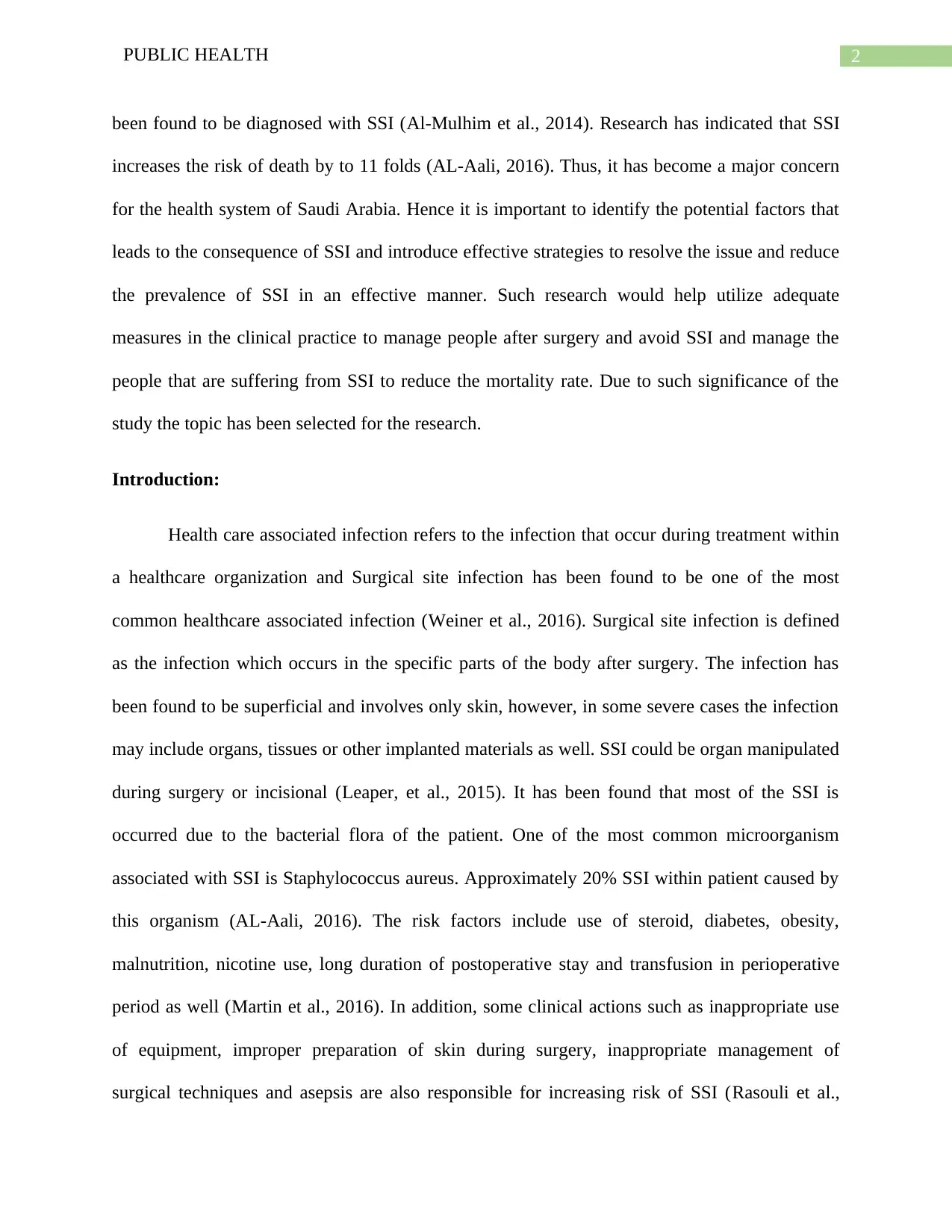
2PUBLIC HEALTH
been found to be diagnosed with SSI (Al-Mulhim et al., 2014). Research has indicated that SSI
increases the risk of death by to 11 folds (AL-Aali, 2016). Thus, it has become a major concern
for the health system of Saudi Arabia. Hence it is important to identify the potential factors that
leads to the consequence of SSI and introduce effective strategies to resolve the issue and reduce
the prevalence of SSI in an effective manner. Such research would help utilize adequate
measures in the clinical practice to manage people after surgery and avoid SSI and manage the
people that are suffering from SSI to reduce the mortality rate. Due to such significance of the
study the topic has been selected for the research.
Introduction:
Health care associated infection refers to the infection that occur during treatment within
a healthcare organization and Surgical site infection has been found to be one of the most
common healthcare associated infection (Weiner et al., 2016). Surgical site infection is defined
as the infection which occurs in the specific parts of the body after surgery. The infection has
been found to be superficial and involves only skin, however, in some severe cases the infection
may include organs, tissues or other implanted materials as well. SSI could be organ manipulated
during surgery or incisional (Leaper, et al., 2015). It has been found that most of the SSI is
occurred due to the bacterial flora of the patient. One of the most common microorganism
associated with SSI is Staphylococcus aureus. Approximately 20% SSI within patient caused by
this organism (AL-Aali, 2016). The risk factors include use of steroid, diabetes, obesity,
malnutrition, nicotine use, long duration of postoperative stay and transfusion in perioperative
period as well (Martin et al., 2016). In addition, some clinical actions such as inappropriate use
of equipment, improper preparation of skin during surgery, inappropriate management of
surgical techniques and asepsis are also responsible for increasing risk of SSI (Rasouli et al.,
been found to be diagnosed with SSI (Al-Mulhim et al., 2014). Research has indicated that SSI
increases the risk of death by to 11 folds (AL-Aali, 2016). Thus, it has become a major concern
for the health system of Saudi Arabia. Hence it is important to identify the potential factors that
leads to the consequence of SSI and introduce effective strategies to resolve the issue and reduce
the prevalence of SSI in an effective manner. Such research would help utilize adequate
measures in the clinical practice to manage people after surgery and avoid SSI and manage the
people that are suffering from SSI to reduce the mortality rate. Due to such significance of the
study the topic has been selected for the research.
Introduction:
Health care associated infection refers to the infection that occur during treatment within
a healthcare organization and Surgical site infection has been found to be one of the most
common healthcare associated infection (Weiner et al., 2016). Surgical site infection is defined
as the infection which occurs in the specific parts of the body after surgery. The infection has
been found to be superficial and involves only skin, however, in some severe cases the infection
may include organs, tissues or other implanted materials as well. SSI could be organ manipulated
during surgery or incisional (Leaper, et al., 2015). It has been found that most of the SSI is
occurred due to the bacterial flora of the patient. One of the most common microorganism
associated with SSI is Staphylococcus aureus. Approximately 20% SSI within patient caused by
this organism (AL-Aali, 2016). The risk factors include use of steroid, diabetes, obesity,
malnutrition, nicotine use, long duration of postoperative stay and transfusion in perioperative
period as well (Martin et al., 2016). In addition, some clinical actions such as inappropriate use
of equipment, improper preparation of skin during surgery, inappropriate management of
surgical techniques and asepsis are also responsible for increasing risk of SSI (Rasouli et al.,
⊘ This is a preview!⊘
Do you want full access?
Subscribe today to unlock all pages.

Trusted by 1+ million students worldwide
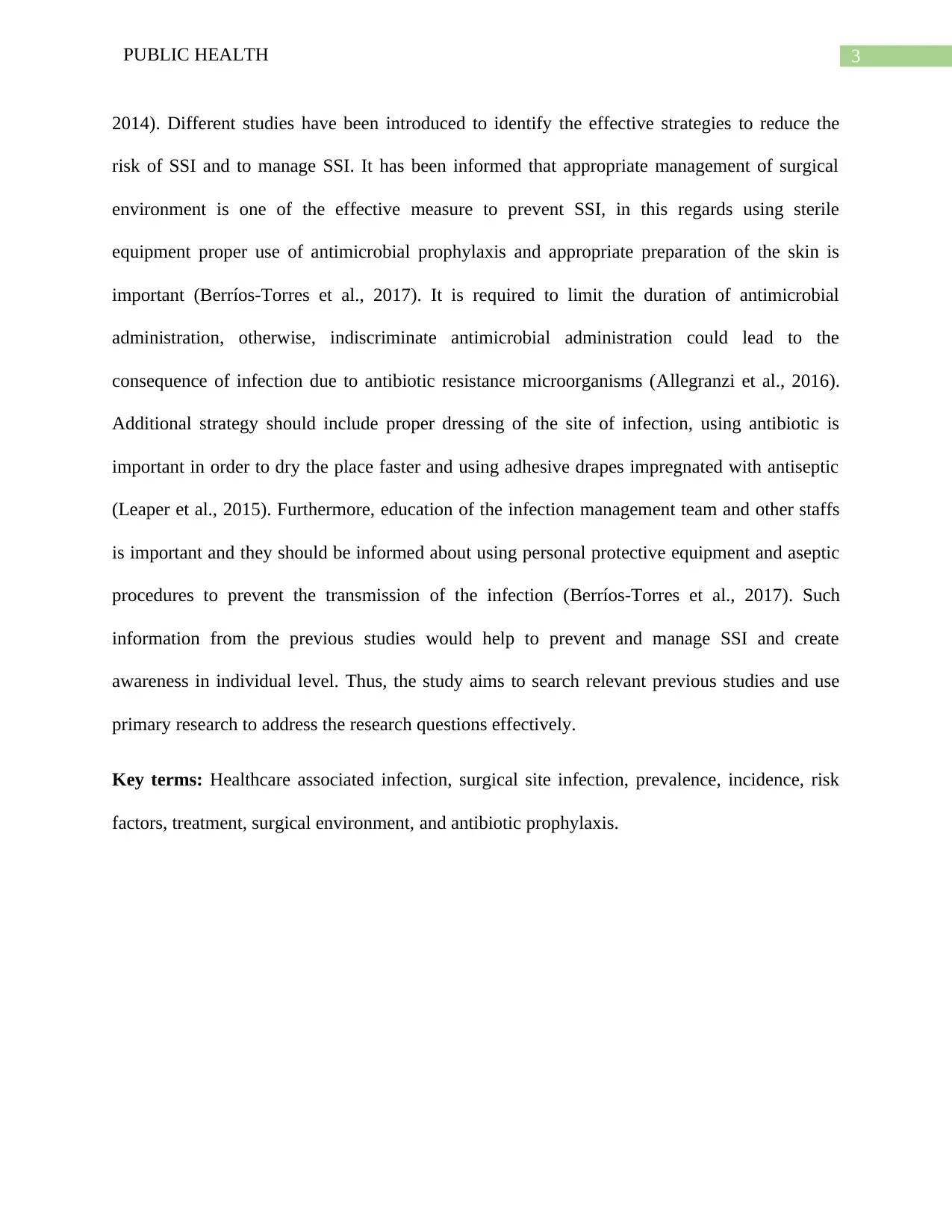
3PUBLIC HEALTH
2014). Different studies have been introduced to identify the effective strategies to reduce the
risk of SSI and to manage SSI. It has been informed that appropriate management of surgical
environment is one of the effective measure to prevent SSI, in this regards using sterile
equipment proper use of antimicrobial prophylaxis and appropriate preparation of the skin is
important (Berríos-Torres et al., 2017). It is required to limit the duration of antimicrobial
administration, otherwise, indiscriminate antimicrobial administration could lead to the
consequence of infection due to antibiotic resistance microorganisms (Allegranzi et al., 2016).
Additional strategy should include proper dressing of the site of infection, using antibiotic is
important in order to dry the place faster and using adhesive drapes impregnated with antiseptic
(Leaper et al., 2015). Furthermore, education of the infection management team and other staffs
is important and they should be informed about using personal protective equipment and aseptic
procedures to prevent the transmission of the infection (Berríos-Torres et al., 2017). Such
information from the previous studies would help to prevent and manage SSI and create
awareness in individual level. Thus, the study aims to search relevant previous studies and use
primary research to address the research questions effectively.
Key terms: Healthcare associated infection, surgical site infection, prevalence, incidence, risk
factors, treatment, surgical environment, and antibiotic prophylaxis.
2014). Different studies have been introduced to identify the effective strategies to reduce the
risk of SSI and to manage SSI. It has been informed that appropriate management of surgical
environment is one of the effective measure to prevent SSI, in this regards using sterile
equipment proper use of antimicrobial prophylaxis and appropriate preparation of the skin is
important (Berríos-Torres et al., 2017). It is required to limit the duration of antimicrobial
administration, otherwise, indiscriminate antimicrobial administration could lead to the
consequence of infection due to antibiotic resistance microorganisms (Allegranzi et al., 2016).
Additional strategy should include proper dressing of the site of infection, using antibiotic is
important in order to dry the place faster and using adhesive drapes impregnated with antiseptic
(Leaper et al., 2015). Furthermore, education of the infection management team and other staffs
is important and they should be informed about using personal protective equipment and aseptic
procedures to prevent the transmission of the infection (Berríos-Torres et al., 2017). Such
information from the previous studies would help to prevent and manage SSI and create
awareness in individual level. Thus, the study aims to search relevant previous studies and use
primary research to address the research questions effectively.
Key terms: Healthcare associated infection, surgical site infection, prevalence, incidence, risk
factors, treatment, surgical environment, and antibiotic prophylaxis.
Paraphrase This Document
Need a fresh take? Get an instant paraphrase of this document with our AI Paraphraser
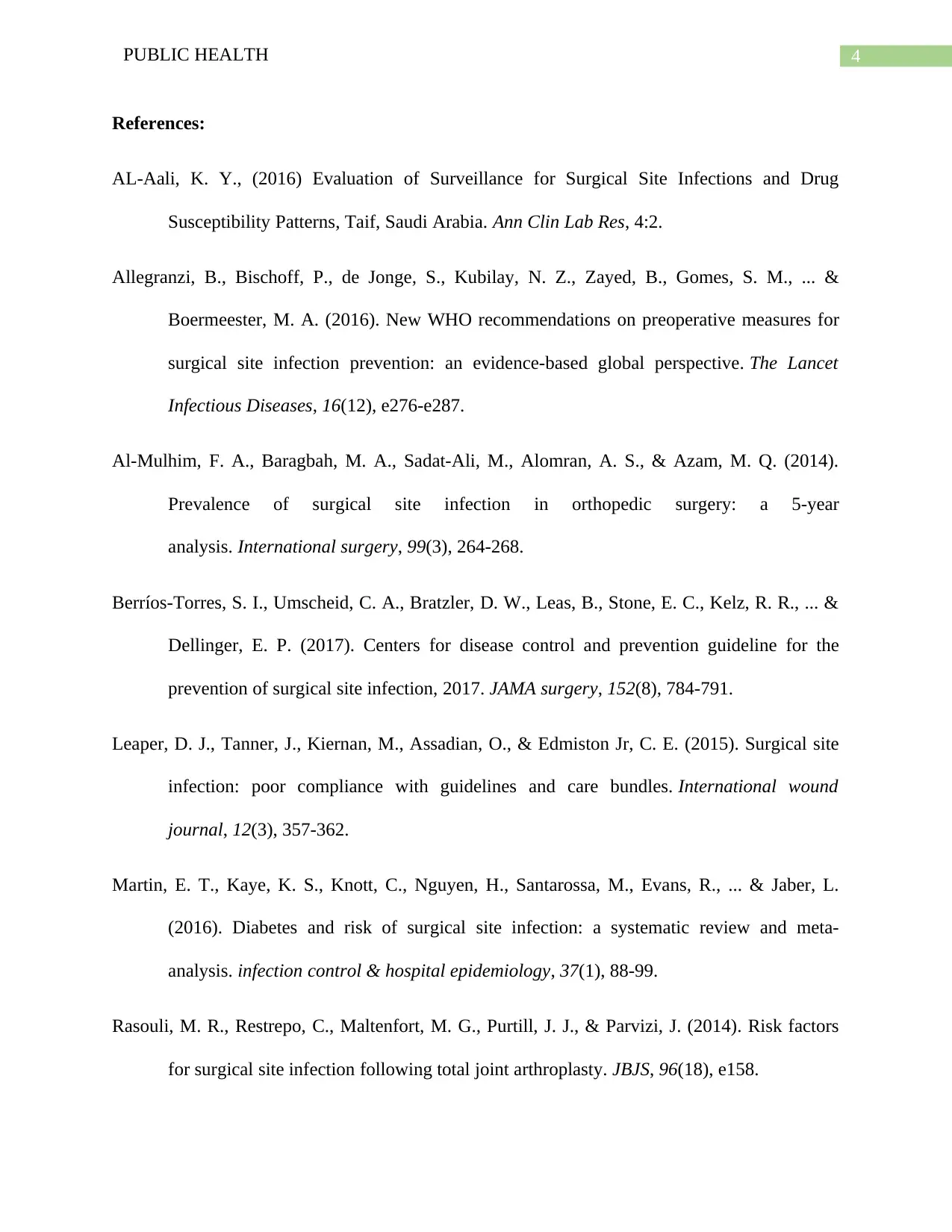
4PUBLIC HEALTH
References:
AL-Aali, K. Y., (2016) Evaluation of Surveillance for Surgical Site Infections and Drug
Susceptibility Patterns, Taif, Saudi Arabia. Ann Clin Lab Res, 4:2.
Allegranzi, B., Bischoff, P., de Jonge, S., Kubilay, N. Z., Zayed, B., Gomes, S. M., ... &
Boermeester, M. A. (2016). New WHO recommendations on preoperative measures for
surgical site infection prevention: an evidence-based global perspective. The Lancet
Infectious Diseases, 16(12), e276-e287.
Al-Mulhim, F. A., Baragbah, M. A., Sadat-Ali, M., Alomran, A. S., & Azam, M. Q. (2014).
Prevalence of surgical site infection in orthopedic surgery: a 5-year
analysis. International surgery, 99(3), 264-268.
Berríos-Torres, S. I., Umscheid, C. A., Bratzler, D. W., Leas, B., Stone, E. C., Kelz, R. R., ... &
Dellinger, E. P. (2017). Centers for disease control and prevention guideline for the
prevention of surgical site infection, 2017. JAMA surgery, 152(8), 784-791.
Leaper, D. J., Tanner, J., Kiernan, M., Assadian, O., & Edmiston Jr, C. E. (2015). Surgical site
infection: poor compliance with guidelines and care bundles. International wound
journal, 12(3), 357-362.
Martin, E. T., Kaye, K. S., Knott, C., Nguyen, H., Santarossa, M., Evans, R., ... & Jaber, L.
(2016). Diabetes and risk of surgical site infection: a systematic review and meta-
analysis. infection control & hospital epidemiology, 37(1), 88-99.
Rasouli, M. R., Restrepo, C., Maltenfort, M. G., Purtill, J. J., & Parvizi, J. (2014). Risk factors
for surgical site infection following total joint arthroplasty. JBJS, 96(18), e158.
References:
AL-Aali, K. Y., (2016) Evaluation of Surveillance for Surgical Site Infections and Drug
Susceptibility Patterns, Taif, Saudi Arabia. Ann Clin Lab Res, 4:2.
Allegranzi, B., Bischoff, P., de Jonge, S., Kubilay, N. Z., Zayed, B., Gomes, S. M., ... &
Boermeester, M. A. (2016). New WHO recommendations on preoperative measures for
surgical site infection prevention: an evidence-based global perspective. The Lancet
Infectious Diseases, 16(12), e276-e287.
Al-Mulhim, F. A., Baragbah, M. A., Sadat-Ali, M., Alomran, A. S., & Azam, M. Q. (2014).
Prevalence of surgical site infection in orthopedic surgery: a 5-year
analysis. International surgery, 99(3), 264-268.
Berríos-Torres, S. I., Umscheid, C. A., Bratzler, D. W., Leas, B., Stone, E. C., Kelz, R. R., ... &
Dellinger, E. P. (2017). Centers for disease control and prevention guideline for the
prevention of surgical site infection, 2017. JAMA surgery, 152(8), 784-791.
Leaper, D. J., Tanner, J., Kiernan, M., Assadian, O., & Edmiston Jr, C. E. (2015). Surgical site
infection: poor compliance with guidelines and care bundles. International wound
journal, 12(3), 357-362.
Martin, E. T., Kaye, K. S., Knott, C., Nguyen, H., Santarossa, M., Evans, R., ... & Jaber, L.
(2016). Diabetes and risk of surgical site infection: a systematic review and meta-
analysis. infection control & hospital epidemiology, 37(1), 88-99.
Rasouli, M. R., Restrepo, C., Maltenfort, M. G., Purtill, J. J., & Parvizi, J. (2014). Risk factors
for surgical site infection following total joint arthroplasty. JBJS, 96(18), e158.
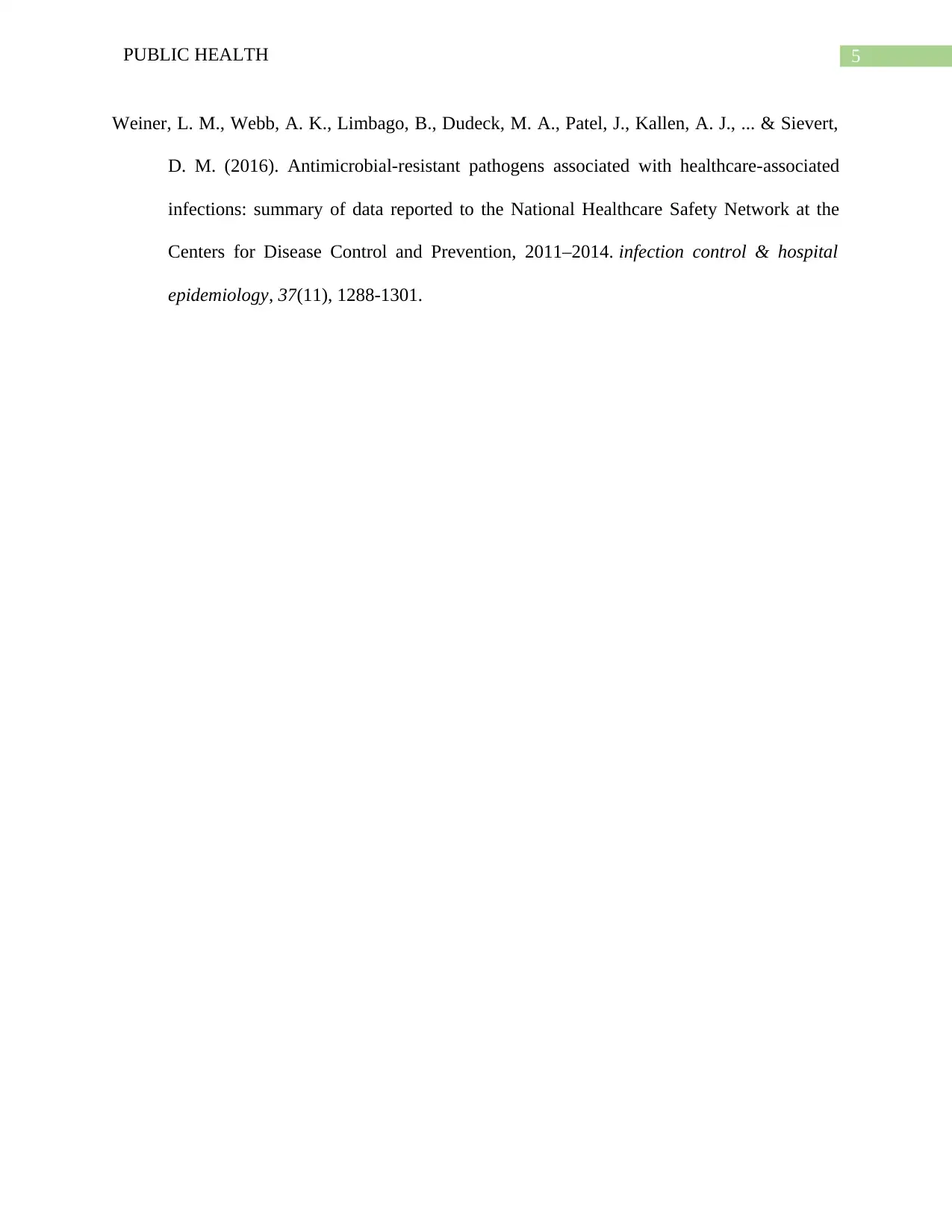
5PUBLIC HEALTH
Weiner, L. M., Webb, A. K., Limbago, B., Dudeck, M. A., Patel, J., Kallen, A. J., ... & Sievert,
D. M. (2016). Antimicrobial-resistant pathogens associated with healthcare-associated
infections: summary of data reported to the National Healthcare Safety Network at the
Centers for Disease Control and Prevention, 2011–2014. infection control & hospital
epidemiology, 37(11), 1288-1301.
Weiner, L. M., Webb, A. K., Limbago, B., Dudeck, M. A., Patel, J., Kallen, A. J., ... & Sievert,
D. M. (2016). Antimicrobial-resistant pathogens associated with healthcare-associated
infections: summary of data reported to the National Healthcare Safety Network at the
Centers for Disease Control and Prevention, 2011–2014. infection control & hospital
epidemiology, 37(11), 1288-1301.
⊘ This is a preview!⊘
Do you want full access?
Subscribe today to unlock all pages.

Trusted by 1+ million students worldwide
1 out of 6
Related Documents
Your All-in-One AI-Powered Toolkit for Academic Success.
+13062052269
info@desklib.com
Available 24*7 on WhatsApp / Email
![[object Object]](/_next/static/media/star-bottom.7253800d.svg)
Unlock your academic potential
Copyright © 2020–2025 A2Z Services. All Rights Reserved. Developed and managed by ZUCOL.





